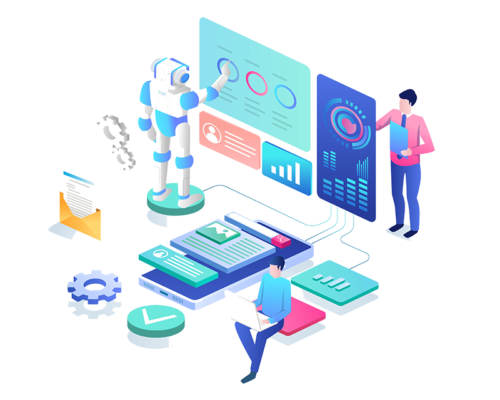In the ever-evolving landscape of information technology, efficiency, and optimization are crucial for business success. With the surging demand for streamlined processes and reduced operational costs, the role of Robotic Process Automation (RPA) has become increasingly significant. As 2024 unfolds, RPA continues redefining how IT tasks are managed, setting a new standard for operational excellence.
Understanding Robotic Process Automation
Robotic Process Automation, often abbreviated as RPA, is a technology that utilizes software robots or ‘bots’ to automate repetitive, rule-based tasks within business processes. These bots are designed to perform tasks carried out by humans, working across various applications and systems. RPA seamlessly engages with the current IT framework and systems, initiating actions, handling data manipulation, and establishing communication with various digital systems.
Differentiating RPA from AI
Although RPA and Artificial Intelligence (AI) streamline Business Process Automation in the bottom line, they serve different purposes. RPA focuses on automating rule-based, repetitive tasks, mimicking human actions within a structured environment.
On the other hand, AI involves machines simulating human intelligence, enabling them to learn, reason, and make decisions. While RPA follows predefined rules, AI systems can adapt, learn from experience, and make decisions based on evolving data patterns.
Robotic Process Automation Stats 2024
- 95% of organizations using robotic process automation (RPA) say that implementation of RPA has improved productivity. The study also found that 93% of those believe it has improved compliance, 81% say it has reduced costs, and 77% claim it has provided better management information.
- 46% of IT management leaders utilize RPA, while 38% of marketing leaders rely on RPA to enhance their day-to-day operations.
- 70% of businesses that integrated RPA report substantial time savings as a result.
- A Gartner study shows that by 2024, companies will decrease operational costs by thirty percent by combining hyper-automation technologies with redesigned operational processes.
As technology fast forwards, the integration of RPA in IT processes is expected to become more sophisticated. It will evolve to handle more complex tasks, collaborate with AI for decision-making, and expand its capabilities in integrating with a wider array of systems and applications. Now, let us see how RPA will evolve in the future.
10 Ways How RPA Will Evolve in the Future
1. Enhanced Cognitive Capabilities
RPA is expected to evolve beyond rule-based automation to incorporate enhanced cognitive capabilities. This means that bots will become more adept at handling unstructured data, making decisions based on complex patterns, and performing tasks requiring higher cognitive reasoning.
2. Synergy with AI for Intelligent Automation
The relationship between RPA and AI will become more emphasized, leading to intelligent automation. RPA will collaborate with AI algorithms to make informed decisions, learn from data patterns, and adapt to dynamic environments. This fusion of technologies will amplify the scope of tasks that can be automated, driving efficiency to unprecedented levels.

3. Advanced Data Analytics Integration
RPA will increasingly leverage advanced data analytics in the future, providing organizations with valuable insights. Bots will automate tasks and analyze data in real-time, offering actionable intelligence to decision-makers. This integration will empower businesses to make informed, data-driven decisions swiftly.
4. Hyper-Automation for Operational Excellence
Hyperautomation involves using various tools like robotic process automation (RPA) and artificial intelligence (AI) to make business decisions smarter and more efficient. Companies will leverage a combination of RPA, AI, machine learning, and other automation technologies to streamline operations, resulting in a projected 30% reduction in operational costs by 2024, as per Gartner.
5. Evolving Skill Sets and Workforce Dynamics
As RPA becomes more sophisticated, the skill sets required to manage and optimize these technologies will evolve. Workforces will need to adapt by acquiring skills in AI, machine learning, and advanced analytics. The human workforce will transition from routine task execution to overseeing and optimizing automated processes.
6. Increased Focus on Security and Compliance
With the growing adoption of RPA in handling sensitive data and critical business processes, there will be an increased emphasis on ensuring security and compliance. RPA solutions will integrate advanced security measures to protect against cyber threats, ensuring that automation does not compromise data integrity or regulatory requirements.
7. Expansion into Diverse Industries
The application of RPA will extend beyond traditional sectors. Industries such as healthcare, finance, and manufacturing will increasingly adopt RPA to automate complex, industry-specific processes. This diversification will contribute to a broader spectrum of RPA use cases in various domains.
8. Continuous Evolution of RPA Platforms
RPA solution providers will continue to enhance their platforms, introducing new features and capabilities. This will include user-friendly interfaces, improved scalability, and the ability to integrate seamlessly with a wide array of applications and systems. The evolving landscape of RPA platforms will cater to the diverse needs of businesses in their automation journey.
9. Streamlining Routine IT Tasks
In IT, numerous routine tasks such as data entry, system monitoring, software installation, and user access management are time-consuming and mundane. RPA steps in to handle these tasks efficiently.
For instance, it can automate software deployment and patch management, ensuring consistency and accuracy across systems. This not only reduces human errors but also enables IT professionals to concentrate more on strategic and complex issues.
10. Reducing Operational Costs
One of the most significant advantages of implementing RPA in IT processes is its impact on operational costs. By automating repetitive tasks, organizations can reduce labor costs, minimize human errors, and enhance productivity. The cost savings generated by RPA implementation can be substantial, contributing to the optimization of overall operational expenses.
Challenges and Opportunities in RPA
Despite its transformative potential, RPA deployment is not without its challenges. Ensuring seamless integration with existing systems, addressing security concerns, and managing the impact on the workforce’s skill set remain pivotal challenges. Yet, these challenges also bring opportunities for innovation, skill development, and redefining the nature of work in the digital era.
Wrapping Up
Integrating RPA in IT processes is a pivotal driver of efficiency, cost reduction, and overall operational excellence. The ability of RPA to handle routine tasks liberates human potential, enabling IT professionals to focus on innovation and more complex problem-solving, ultimately driving business growth and success.

